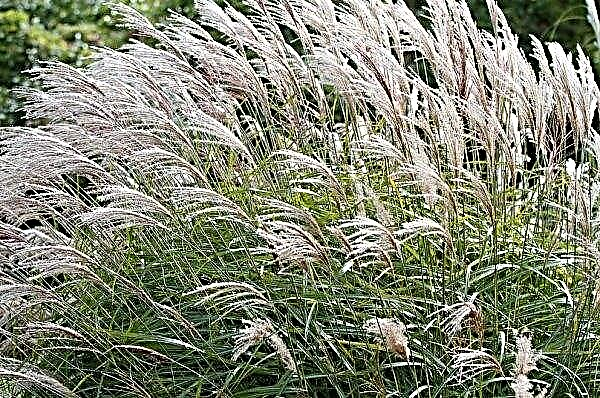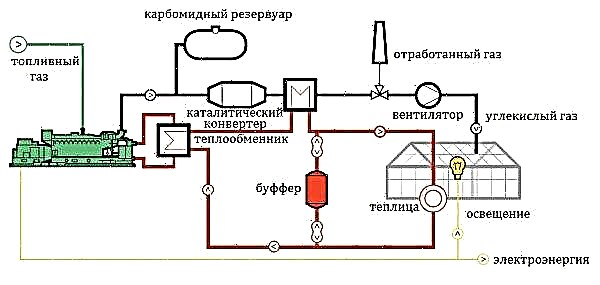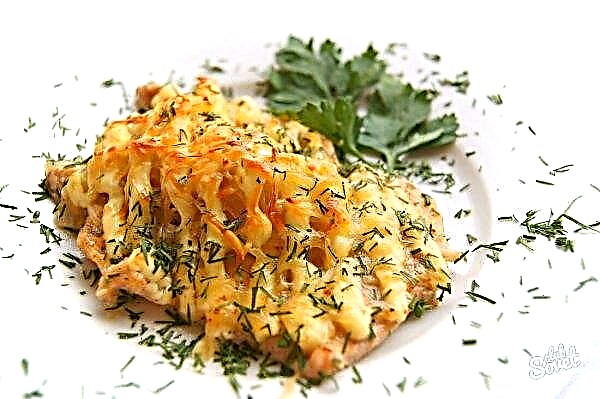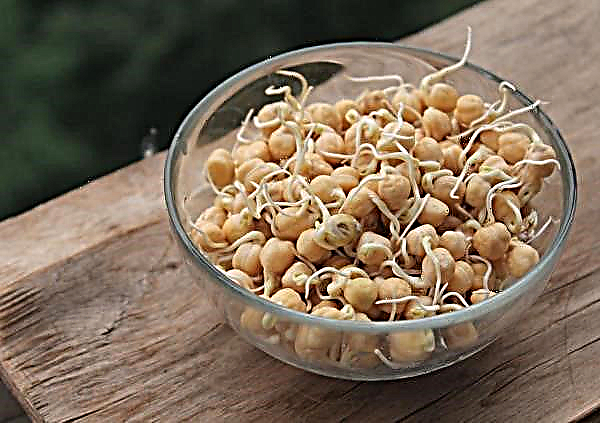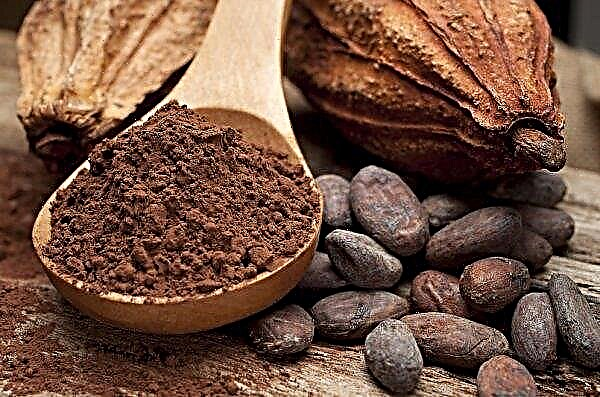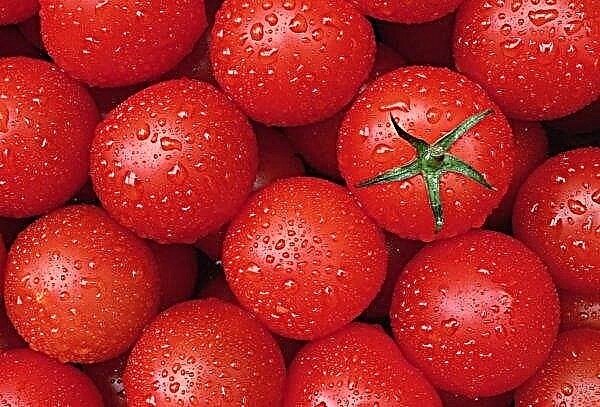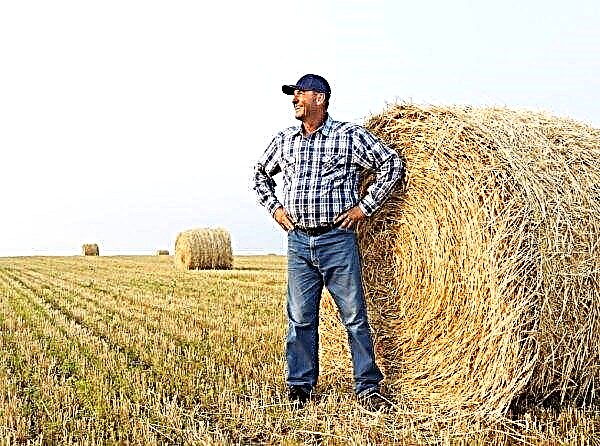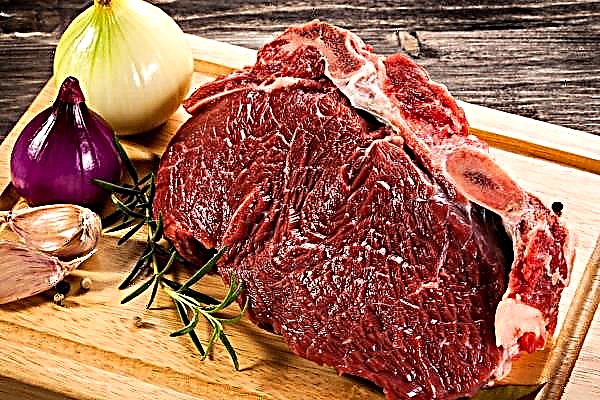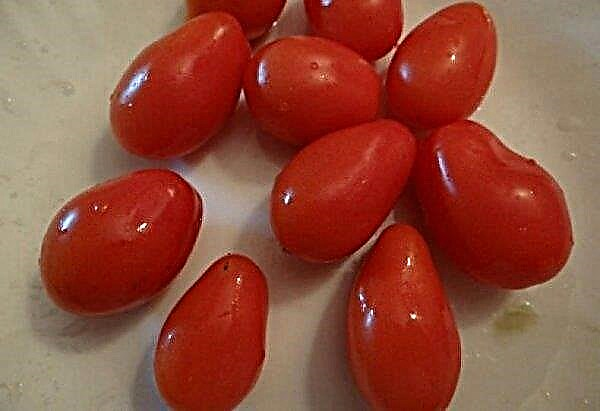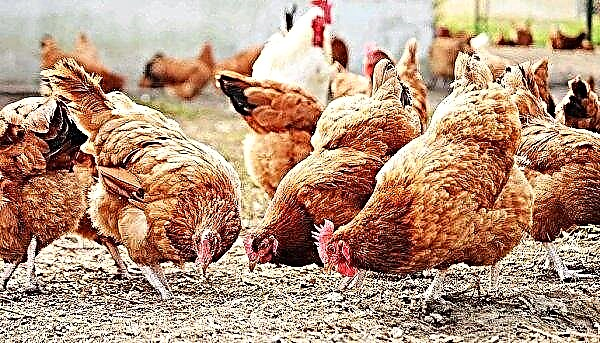One of the most common varieties of apples suitable for growing in large and small garden plots is the Medunitsa variety. Trees annually give a bountiful harvest, and their honey fruits are widely used fresh and for preparing a variety of dishes. The main characteristics of the Medunitsa apple tree, especially the planting of seedlings, the subtleties of caring for trees, as well as the basic rules for dealing with possible difficulties encountered when growing a crop are listed below in the article.
Fruit Description
The variety got its name in honor of the fragrant flower of the Lungwort blooming in spring. Ripe fruits have excellent taste, and their quantity is large even when growing crops in adverse environmental conditions. More detailed characteristics of apples Medunitsa - later in the article.
Calorie content
Apples of this variety are very sweet. - their pulp contains about 14% of sugars, and the amount of ascorbic acid in 100 g of fruits does not exceed 8 mg. Ripe fruits of Lungwort are very beneficial for the body. They contain chlorogenic acid, which stimulates the digestive system and the antioxidant quercetin, which helps to eliminate harmful substances from the body. The calorie content of 100 g of fruits is 47 kcal.
Did you know? The oldest apple tree grows in a garden in Manhattan (USA). The tree was planted in 1647 by Peter Stuvesant and still bears fruit.
Description of the energy value of apples is presented below:
- proteins - 0.4 g;
- fats - 0.3 g;
- carbohydrates - 11.3 g.

Taste
The Medunitsa variety has gained popularity among many gardeners due to the high palatability of ripe apples. During storage, the fruits become even sweeter during the first 2 weeks after harvest.
Did you know? About 25% of the apple mass is air, so these fruits do not drown in water.
Description of the taste characteristics of Medunitsa is presented below:
- the pulp of fruits is saturated with juice and has a dense consistency;
- the inside of the fetus is painted in a light yellow color;
- apples are sweet, have a honey aftertaste;
- tasting assessment of the taste of the variety on a 5-point scale is 4.3 points;
- unripe fruits are also sweet and can be eaten;
- during long-term storage, the taste of the fruit becomes less saturated, and the pleasant aroma of the pulp disappears.
 To taste, apples of this variety are similar to the well-known autumn variety Honey Ranet, but differ in earlier ripening.
To taste, apples of this variety are similar to the well-known autumn variety Honey Ranet, but differ in earlier ripening.Fruit Sizes
Apples of the Medunitsa variety abundantly cover tree branches and look very compact on them. Fruits have an attractive appearance, which is well preserved even after transporting them over long distances. Therefore, this variety is always in demand among buyers.
Important! To limit the growth of the apple tree in height and prevent excessive thickening of the branches, which complicates the ripening and harvesting of apples, pruning is performed.
The main qualities of apples Medunitsa are:
- the fruits are small and medium in size;
- the shape of the fruit may be round-conical or slightly flattened;
- the mass of a ripe apple is 100-150 g;
- outside, the fruits are covered with a dense and smooth peel of a greenish-yellow color with a reddish or brown blush;
- the upper part of the fruit is moderately ribbed;
- attractive presentation of apples does not worsen throughout the entire fruiting period.
 The Medunitsa apple-tree is inferior in size to another popular Medovka variety, but unlike them, it has a sweeter taste.
The Medunitsa apple-tree is inferior in size to another popular Medovka variety, but unlike them, it has a sweeter taste.Tree height
Trees of this variety are tall, and their crown has the shape of a pyramid and tapers to the top. It consists of branches extending from the trunk at an acute angle and looks very spreading. The main conductor and side branches of the tree grow very quickly, the height of an adult tree is about 7 m, and sometimes can reach 10 m.
Application
Due to good taste characteristics and attractive appearance, apples of the Medunitsa variety are eaten fresh without any processing. But sugary fruits are also widely used in cooking. From them are prepared:
- fruit desserts;
- apple compotes and juices;
- a filling for sweet pastries;
- jam and jam;
- dried fruits;
- canned preparations.
In addition to heat treatment Medunitsa apples are sometimes frozen to increase fresh shelf life. The fruit is cut into small pieces, placed in clean containers or bags and stored in the freezer.
Video: how to freeze apples for the winter
Grade characteristics
There are two varieties of Medunitsa apple trees - summer and winter. The main difference between them is the timing of the ripening of the crop and the duration of its storage. In appearance, representatives of these two species almost do not differ from each other.
The main characteristics of Medunitsa trees are listed below:
- The root system is powerful and branched. It provides good stability of the apple tree, but is not far from the surface of the soil.
- The branches of the tree are powerful and strong, slightly hanging down. They are densely covered with leaves and painted in a light brown color.
- The leaves are painted green with a yellowish tint and have different sizes. They can be rounded or elongated, and their matte embossed surface is rough to the touch.
- The flowering period falls in May or early June. The flowers of the apple tree Medunitsa can reach 5 cm in diameter, and their petals are painted white.
- Trees have good immunity, with proper care they are rarely affected by fungal diseases.

Productivity
Apple-tree Medunitsa belongs to the high-yielding varieties. At the same time, the size of fruits does not decrease over the years and their positive taste is fully preserved. The main characteristics of the yield of the variety are as follows:
- the fruiting period begins 5 years after planting an apple tree;
- about 180 kg of fruit is picked from one tree;
- during the first 10-15 years after the beginning of fruiting, the apple tree gives a regular and abundant crop, and then there is an alternation of generous and low-yielding years;
- to increase the number of ripe fruits, it is recommended to normalize the number of ovaries formed on the tree;
- fruiting duration under good growing conditions can reach 50 years.
Did you know? Apple bones contain a dangerous substance - amygdalin glycoside. When it enters the human stomach, it breaks down and releases hydrocyanic acid, which is a strong poison.
Frost resistance
Wood has good low temperature resistance, therefore, it can be grown both in the southern regions and in areas with a temperate and cold climate.
The main characteristics of frost resistance of this culture are listed below:

- the apple tree tolerates even severe winters with severe frosts down to –40 ° С;
- when grown in adverse climate conditions, the yield and taste of ripe apples do not deteriorate;
- young seedlings are more sensitive to the effects of low temperatures, so it is recommended to cover them for the winter, wrapping the trunk with a layer of burlap;
- for a better wintering of the tree in autumn, you need to dig and mulch the soil around it, and tie the stems with twigs of spruce branches.
Pollinators
Apple-tree Medunitsa belongs to self-fertile trees - male and female flowers pollinating each other are formed on it. But to increase productivity next to this variety, it is recommended to plant other species of apple trees that bloom in the same period of time and will provide cross-pollination.
The following varieties are recognized as the best pollinators for Medunitsa:
- White filling;
- Brown striped;
- Anis Sverdlovsky;
- Victory Chernenko;
- Bellefleur Chinese.

Features of planting, growing and care
Trees of this variety are unpretentious to environmental conditions, therefore, they can give a good harvest even in regions with an unfavorable climate. But for the successful cultivation of Medunitsa on the site, you need to choose high-quality planting material and plant seedlings correctly. After the young trees have successfully taken root in the ground.
They need to be provided with sufficient moisture and nutrients, and fast-growing shoots of apple trees need to be pruned in order to form the correct crown. About the main features of planting seedlings and care for adult trees of the Medunitsa variety - later in the article.
Important! When choosing planting material, you need to evaluate its appearance - the trunk and shoots should be smooth and elastic, and the root system is well developed.
Landing time
The time of planting apple seedlings is determined depending on the region of cultivation and specific climatic conditions. This procedure must be carried out so that young apple trees do not suffer from the cold. The planting dates for Medunitsa are listed below:
- in the southern regions and central regions, seedlings are planted in open ground from late September to early November;
- in autumn, young trees are planted on the site no earlier than 2-3 weeks before frost, so that the apple tree does not have time to release buds before winter;
- in areas with little snowy winters and cold climates, apple trees are planted in early spring before buds begin to bloom;
- at the time of planting the seedlings, the ground should thaw to a depth of at least 60 cm and be easy to dig.

Preparing planting material
When buying seedlings, it is recommended to choose those whose age is 2 years. Such trees are already strong enough for planting in open ground and are able to quickly adapt to a new place.
To prepare the seedlings of the Medunitsa variety for planting, you need to perform the following actions:
- if the planting of a young tree is not planned immediately after purchase, then its roots need to be wrapped in a plastic bag with holes made and placed in a dark and cool cellar;
- before planting, the main conductor is cut at a height of 70 cm - this will stimulate the active growth of side branches;
- if, when examining the root system of a young tree, damaged or decayed roots were found, then they need to be trimmed.
 Shabby roots before planting can be cut at right angles.
Shabby roots before planting can be cut at right angles.Landing technology
It is recommended to grow the Medunitsa apple tree in an open and spacious area with light loamy soil, which passes moisture well. When planting, they adhere to the scheme according to which the distance between neighboring trees in one row is 4.5 m, and between rows - at least 5 m. If planting is planned for autumn, then holes for seedlings are dug 2-3 weeks before the procedure, and when spring planting of seedlings landing pits prepared in the fall. 1) the upper fertile soil layer; 2) the upper fertile soil layer with the addition of humus and mineral fertilizers; 3) soil layer without fertilizers; 4) the root neck (the place of transition of the root system into the trunk)
1) the upper fertile soil layer; 2) the upper fertile soil layer with the addition of humus and mineral fertilizers; 3) soil layer without fertilizers; 4) the root neck (the place of transition of the root system into the trunk)
A step-by-step algorithm for planting the Medunitsa apple tree is presented below:
- Prepare holes for seedlings in advance. The diameter of the pit should be about 50 cm, and the depth of about 1 m. The dimensions of the recess should be 2 times the diameter of the roots of the seedling.
- Divide the earth obtained by digging a hole into two equal parts. In one of them add 2 buckets of humus, 100 g of potassium sulfate and 500 g of superphosphate, and then put the mixture on the bottom of the pit in the form of a knoll.
- Drive a vertical support into the center of the recess for garter of the seedling and leave a hole for shrinkage of the ground. You can cover it with a film on top so that the soil does not dry out.
- Before landing, dig in the earth around the landing pit to saturate it with oxygen.
- When the time comes for planting, place the seedling in a pit and spread its roots on the surface of a mound of fertile soil mixture. The root neck should be at least 7 cm above the surface of the soil.
- Sprinkle the roots of the tree with loose soil to the very top edge of the pit, and slightly compact the soil around the trunk with your hands.
- Gently pour the seedling with 2-3 buckets of water and tie it to the support. In order to keep the soil around the trunk moist longer, you can cover it with a layer of mulch.
Video: instructions for planting an apple tree
What is better to grow from?
Any apple tree can be grown not only from seedlings, but also from seeds - in this case, seeds obtained from ripe apples are used as planting material. In the fall, the seeds are dried, stratified, and then immersed in the soil and by the spring receive a young seedling. But it does not preserve the varietal characteristics of the fruit crop, therefore, it is subsequently used as a stock for grafting the shoot of an apple tree of the desired variety. Vaccination is carried out when the stem thickness of the young seedling reaches 2 cm - this occurs at the end of summer or the next year in spring.
 Eyelet for peeling: 1 - young shoot (dashes indicate the location of cuttings of cuttings on the shoots); 2 - a shank prepared for budding; 3 - section of the bark on a stock; 4 - a cut of a guard; 5 - cut line of the flap; 6 - a guard; 7 - insert the shield for the cortex; 8 - wrapping the grafting site with plastic tape
Eyelet for peeling: 1 - young shoot (dashes indicate the location of cuttings of cuttings on the shoots); 2 - a shank prepared for budding; 3 - section of the bark on a stock; 4 - a cut of a guard; 5 - cut line of the flap; 6 - a guard; 7 - insert the shield for the cortex; 8 - wrapping the grafting site with plastic tape
The process of growing an apple tree Medunitsa from seeds takes more time and requires the gardener to take a number of additional actions, including independently collecting and preparing planting material, planting it, caring for a young seedling and grafting varietal shoots taken from an apple tree. therefore it’s better and easier to grow this crop from ready-made seedlings, which you can buy in a specialty store.
Watering
A growing young tree needs a lot of water for normal development, and after the fruiting starts regular watering will help to get a large number of fruits with high sugar in the pulp. But irrigate the Medunitsa apple tree according to certain rules, since over-saturation of the earth with moisture can cause various diseases and root rot.
The basic rules for watering trees of this variety are listed below:
- during the first 4 weeks after planting, the seedling is watered as the soil dries around the trunk, and then - about once a week;
- about one liter of tree consumes about 10 liters of water;
- so as not to erode the earth around the roots of the apple tree, you can dig a small groove around it and pour water there - this will help to evenly distribute moisture around the roots;
- when grown in temperate regions, trees are irrigated once every 2 weeks;
- 30-40 l of water is recommended for one adult apple tree;
- in conditions of drought or hot climate, watering is carried out about 2 times a week.
Did you know? The giant apple was grown in 2005 in the city of Hirosaki (Japan). The weight of the fruit was 1.85 kg!
Top dressing
Nutrients allow young non-fruiting seedlings of Medunitsa to actively grow green mass, and for adult trees they are a necessary condition for an abundant harvest of sweet apples. You need to feed the seedlings starting from the next year after planting, and the rules for fertilizing young trees differ from the feeding of adult apple trees that produce crops.
Recommendations for feeding trees that have not entered the fruiting phase are listed below:
- in early spring, young seedlings are watered with a urea solution - 50 g of the drug is diluted in a bucket of water;
- in early summer, it is recommended to treat the crown of the apple tree with a solution of sodium humate;
- in the first half of September, 10 l of water is added under each tree with 60 g of superphosphate dissolved in it.
Video: how to feed apple trees
The basic rules for fertilizing an adult apple tree Medunitsa are listed below:
- in the second half of April, 500 g of carbonate is added under each tree - the substance is added during the digging of the soil around the trunk;
- before flowering, an infusion of 2 buckets of water, 100 g of superphosphate, 80 g of potassium and 50 g of carbonate is prepared - the mixture is allowed to infuse for 7 days, and then watered with an apple tree;
- after flowering, the trees are watered with a solution of 2 buckets of water, 2 g of humate and 100 g of nitrophoska;
- Before the beginning of winter, during digging of the tree trunk, 1 bucket of humus and 300 g of potassium sulfate and superphosphate are introduced under each apple tree.
Important! In order for fertilizers to be better absorbed, it is recommended to water the tree before and after feeding.
Cropping and shaping the crown
A fast-growing apple tree needs regular pruning every spring and autumn. This procedure begins to be carried out starting from 2 years after planting a seedling. In the spring, they perform forming pruning, which consists in the construction of tiers of branches and helps to give the crown a pyramidal shape. In the fall, only sanitary pruning is carried out.
The main recommendations for this procedure are listed below:
- spring pruning is carried out in March before the start of sap flow and budding, and autumn pruning in October, after harvesting;
- damaged and dried branches should be regularly removed both in spring and autumn so that they do not deplete the apple tree;
- crown tiers are formed only during the first 3 years of pruning, and also shorten the main conductor to stimulate the growth of side shoots;
- for the first tier leave 5-6 shoots, for the second - 4-5 branches, and for the third - 2-3 shoots;
- the distance between adjacent tiers is about 30–40 cm;
- for an adult apple tree, it is mandatory to standardize the number of ovaries after flowering;
- in the summer it is recommended to pinch young growths and remove excess leaves that overshadow the apples from the sun;
- after the crown of the tree is formed, it is necessary to thin it every spring to prevent excessive thickening.
 Pruning is carried out using a sharpened secateurs, and all places of the cuts are carefully processed by garden var.
Pruning is carried out using a sharpened secateurs, and all places of the cuts are carefully processed by garden var.Video: how to prune apple trees
Possible growing difficulties
The Medunitsa variety is characterized by good immunity and is rarely affected by diseases and pests, but with improper care, the risk of a problem increases. In addition, from the moment of cultivation of this variety, new scab varieties have appeared that can affect trees under certain conditions. The main types of diseases and pests that can threaten the Medunitsa apple tree are listed below:
- Common scab. This fungal disease affects leaves and fruits. They are covered with brown spots, which gradually increase in size and affect all parts of the tree. The leaves begin to dry and crumble, and the apples rot. To get rid of scab, all areas affected by the infection are removed, and the apple tree is irrigated with antifungal drugs (for example, “Topaz”).
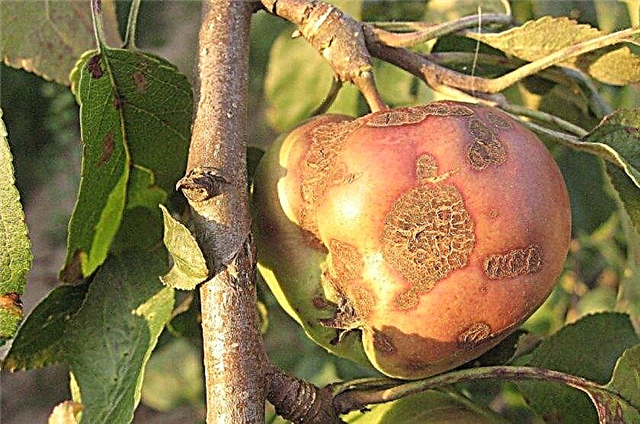
- Fruit rot. The disease affects inflorescences imperceptibly and appears only after the flowering process is complete. Small brown spots form on the ovaries and fruits, which eventually spread to the entire fetus and cause it to rot. Spoiled fruits must be removed from the tree, i.e. they contain fungal colonies and contribute to the further spread of the infection. The crown of a diseased apple tree is sprayed with a solution of colloidal sulfur.

- Powdery Mildew The source of infection is a fungus that infects the leaves and shoots of a tree. As a result of this, they become covered with a powdery white coating, dry and die, and the inflorescences and fruit ovaries crumble. To get rid of the source of infection, you need to cut and burn all the affected leaves, and treat the crown of the apple tree with special preparations (for example, “Skor”).
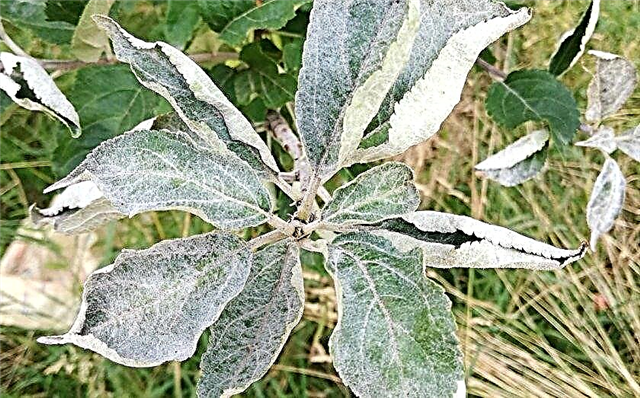
- Tinnitus (leaf flint). In spring, larvae hatch from eggs laid on tree branches, which suck out juice from leaves, petioles and buds. On the affected areas, a sticky white coating is clearly visible, and the leaves and inflorescences begin to fall off en masse. To treat an apple tree, you need to remove all affected areas from it and treat it with insecticides.

- Shield. The larvae of this pest appear on the apple tree after its flowering and stick to the surface of branches and shoots. They drink juice from the bark of a tree and lead to the gradual dying off of shoots along with leaves and fruits. To get rid of the scab, the crown of the apple tree is abundantly irrigated with insecticides.

To prevent these problems, it is recommended to implement the following preventive measures:
- regularly inspect trees for early detection of signs of disease and pest damage;
- spray the apple tree with an aqueous solution of copper sulfate in early spring before buds open (100 g of funds will be needed on a bucket of water);
- before flowering, add 10% nitrate solution to the soil around the trunk, and irrigate the tree crown with a 3% Bordeaux mixture;
- to whitewash the trunk in the fall after harvesting and in the early spring before budding;
- dig in the near-stem circle in spring and autumn to destroy pest larvae;
- remove fallen leaves and rotten fruits from the surface of the soil around the tree;
- pruning in a timely manner to improve air circulation inside the tree crown.
Harvesting and storage
Apples growing on different sides of the tree are illuminated differently by the sun and ripen unevenly. But even after reaching the maturity stage, the fruits remain hanging on the tree and do not crumble. The summer and winter Medunitsa are characterized by different harvest periods, and their fruits have different storage durations:
The summer and winter Medunitsa are characterized by different harvest periods, and their fruits have different storage durations:
- ripe apples of the summer Medunitsa are harvested from late August to late September;
- the fruits of the winter variety of Medunitsa ripen in the interval from mid-September to the end of October;
- fruits are picked from the tree manually in 2-3 approaches, as they reach maturity;
- only apples with whole peels are stored for storage without mechanical damage and rotten areas;
- when stored in a cool dark basement, the fruits of the summer variety remain fresh for 1 month;
- the initial sweet taste and light aroma of apples are preserved only for 2 weeks from the date of harvest;
- the shelf life of the fruits of the winter Medunitsa at an air temperature of +3 ... + 5 ° C is up to 3-4 months.
Important! To increase the shelf life of fresh apples, you can wrap each of them in a layer of paper and lay layers in prepared boxes.
Independently grow an apple tree Medunitsa in its area can even a novice gardener. To do this, it is enough to follow the recommendations for cultivation and care listed in this article, and a generous harvest of sweet and juicy fruits will not take long.
User reviews
I'm growing Medunitsa. Apples, as in the photo, are not small, but not large. This is a variety for those who can not eat apples with sourness, because the fruits of Lungwort are absolutely sweet, tasty, dense, in my opinion, lacking juiciness. They like it more when they lie down, become softer, but this is purely individual. I like the variety, I love sweet apples.







